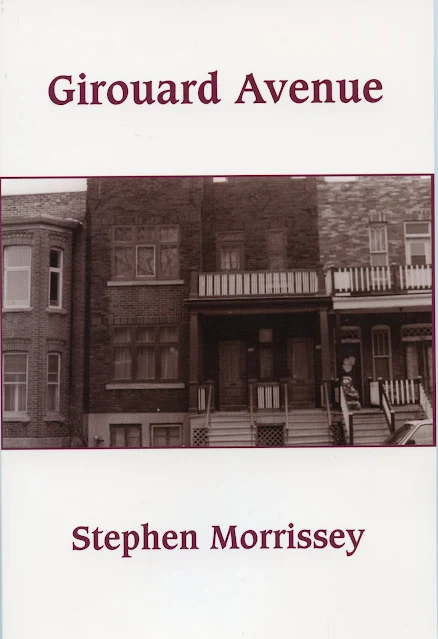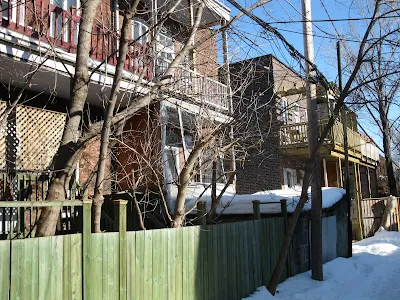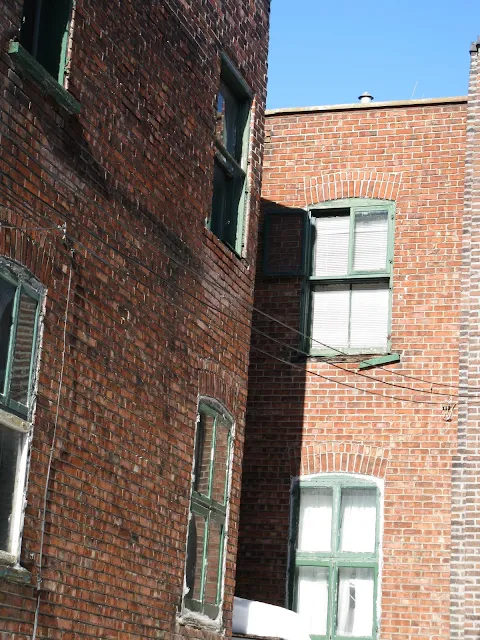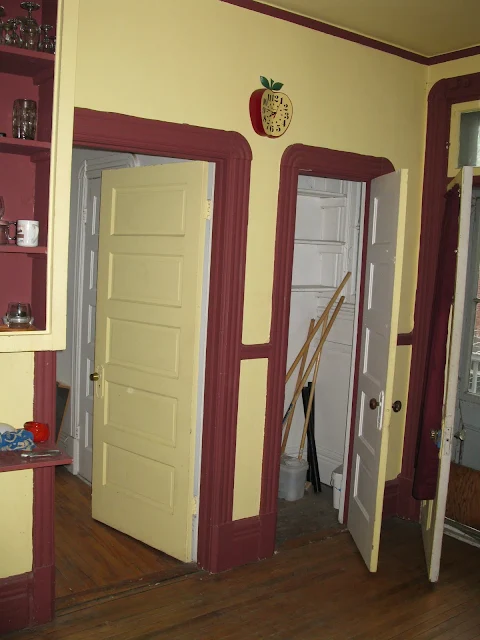 Stained glass window above the front door at 2226 Girouard Avenue.
Stained glass window above the front door at 2226 Girouard Avenue. Our tour of 2226 Girouard Avenue has come to an end. I have other photographs from that visit last April, and I could add a few more photographs to this, but you've seen enough for now. To most people this visit will mean very little--or nothing--and why should it be any other way? For me, this was an exciting journey into the past.
When I returned to the old flat, it really felt as though no time at all had intervened since I was last there, back in 1969. It was as though I had left the place for just a few minutes and then returned, and in that intervening time the place had mysteriously fallen into the state it is now in, all in the blink of an eye. I suppose at some level, emotional or psychological, or spiritual, time doesn't exist except as chronological time. We grow older, the body wears out just like my old white 1994 Honda Civic that CZ named "Pete" after the abbreviated letters on the license plate. "Good old Pete" we say, personifying the car, making it a familar thing, not just a rusting metal vehicle that gets me back and forth to work. Pete is older and more rusted and I, too, am older and seem tired much of the time. That's the effect of chronological time. I think, also, of my old friend Audrey Keyes who I met again in 2005, after not seeing each other for over forty years. There she sat waiting for me that summer day outside of St. Viateur Bagel Restaurant on Monkland Avenue, near Oxford and only a few blocks west of Girouard, and we immediately recognized each other and began chatting away. Time did not seem to exist, not at the emotional and psychological level, but chronologically we were both forty years older.
There is an archetypal value to Girouard Avenue. Maybe it was the first street many of our families lived on as we moved upward in social class, from St. Henry to Notre Dame de Grace, to "NDG," our new neighbourhood. And people living in NDG love the neighbourhood. Girouard is on the eastern edge of NDG as we drive through the underpass at the bottom of the street and then you're in Lower NDG, turn left on St. Jacques and you're headed for St. Henry, St. Cunegonde, Griffintown, Little Burgundy, or Point St. Charles. That's where we came from, my mother born on Irene Street and my father on Marin, both in St. Henry.
We came up in the world, we were educated, we went to university while our parents never finished high school but our parents worked hard and made sure we would also get ahead, and we did. We valued education and we got good jobs and we became "somebodies" (relatively speaking). You begin on Girouard and you move up, to Hoolahan's flats on Oxford Avenue and Audrey and Bobby Keyes, and Mr. and Mrs. Keyes, are your neighbours, more Irish, Irish everywhere, Irish descendants, Irish names. It was either Irish, English, or Jewish; another friend, Ica Shainblum lived across the street and we all played together. A few doors south was Uncle Herbie and Auntie Dorothy's flat, and a few blocks east is Girouard where my grandmother, great Aunt Essie, and Auntie Mable lived, and later (in the early 1960s) my great Aunt Edna moved to Girouard. As I've said before, my parents and my brother and I also lived there in the early 1950s; and over the years, in the 1930s and 1940s, many other family members lived in the flat on Girouard. Even if you move up to the big house on Montclair Avenue, where I lived for thirteen years, you still have one foot in the old street, in the old neighbourhood, and you're proud of it.
So, Girouard Avenue is more than just a street, it is also a border between one neighbourhood and another, one social class and another, one period in our lives and another. It's a psychological border that we've crossed. If you drive north from St. Jacques (few call it St. James anymore) where Girouard begins, then along Girouard to Cote St. Luc Road, to where Girouard ends--it's not a long street--you've run the full extent of it. It's a journey of years and emotions and a journey from the past, frozen in a kind of suspended animation, like my grandmother's old flat.
How many times I have revisited the Girouard flat in dreams, usually my grandmother is absent, maybe one or both of the old great aunts are there. Or it's empty, no one home. So, this makes me think it isn't only the people, it's the place and the place includes and encompasses the people, the beloved relatives and ancestors, and it encompasses all we've done with our lives. I know I could sit down with any of the ancestors, if it were possible, even with great great and great great great grandparents and beyond the greats, as far into the past as one can journey, and it would still be family, flesh and blood, people I love. So, the place, 2226 Girouard Avenue, means all of this to me. And I say "God bless them all," no matter their social status or what they acomplished or didn't accomplish in life. God bless them. God bless them all.
P.S. Driving by the old flat this morning I see extensive work being done on the place. What I have presented here is the last of 2226 Girouard as it used to exist. I caught it just before the end. It will soon be gone.
.JPG)
.JPG)
.JPG)
.JPG)
.JPG)
.JPG)
.JPG)
.JPG)
.JPG)
.JPG)
.JPG)
.JPG)
.JPG)
.JPG)
.JPG)
.JPG)
.JPG)































